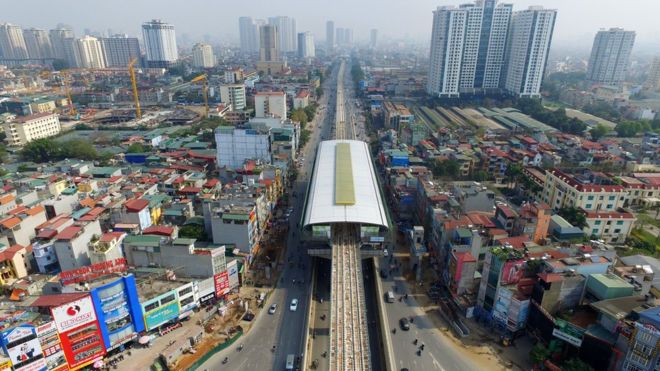Hanoi’s urban railway delayed due to lack of capital: Chinese EPC contractor
- Cat Linh – Ha Dong Railway open to visitors
- Cat Linh – Ha Dong elevated railway to begin test run in October
- Savills: Opportunities in underground urban planning
- Street art rejuvenates Hanoi urban landscape
Deputy Minister of Transportation Nguyen Ngoc Dong recently led a delegation to inspect the construction progress of the Hanoi urban railway route of Cat Linh - Ha Dong.
A representative of the Chinese EPC contractor said that due to their financial difficulties, the progress of construction of the first Hanoi’s urban railway line is again experiencing a delay. He also unveiled that detailed designs of several subprojects have not yet finished.
 |
| Hanoi’s urban railway delayed due to lack of capital: Chinese EPC contractor. |
Deputy Minister Nguyen Ngoc Dong urged the Railway Project Management Board to soon hold a meeting to review all parties involved in the project and to replace the ones that do not meet the requirements.
"At the meeting, the EPC contractor must report in detail the progress of each component and the completion time of the project’s components. The EPC contractor must ensure the project progress under the contract,” said the Deputy Minister of Transport.
The Ministry of Transport will ask the Chinese Embassy for their support in gearing up the project on one hand, and will work with the authority of Chinese Railway Group 6 on the other hand, to force the Chinese EPC contractor to fulfill their commitments fully and on time, he stressed.
The elevated railway project began in 2011 with investment of US$552 million, of which US$169 million came from Chinese official development assistance. In November 2014, it was announced the project would need a total of US$868 million, US$300 million more than initial estimates.
Linking Cat Linh Street in Dong Da district with Yen Nghia station in Ha Dong district, the project includes 12 stations and a depot at Phu Luong ward in Ha Dong district. The elevated project has a length of about 13 km, while the depot in Ha Dong spans 19.6 hectares.
The railway is capable of operating 13 trains with carrier frequency of every two minutes with a maximum speed of 80 kilometres per hour.
The project was due to be completed in 2016 but due to many reasons, it failed to be finished on time. As a result, it is expected to wrap up by the end of the year, then carry out pilot runs, and officially operate in Q2, 2018.

